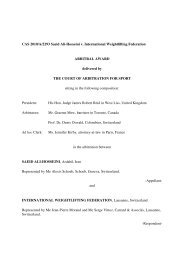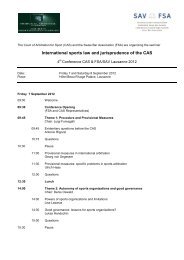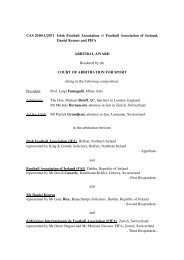(CAS) Bulletin - Tribunal Arbitral du Sport / TAS
(CAS) Bulletin - Tribunal Arbitral du Sport / TAS
(CAS) Bulletin - Tribunal Arbitral du Sport / TAS
Create successful ePaper yourself
Turn your PDF publications into a flip-book with our unique Google optimized e-Paper software.
specifi c gravity of 1.020. Without this correction,<br />
the concentrations of 5OH-MEHP and of 5OXO-<br />
MEHP were respectively 741.7 ng/mL and 323.3<br />
ng/mL (with the effective specifi c gravity of 1.031<br />
measured in the sample of 20 July 2010). These two<br />
concentrations are extremely high; one of them<br />
being more than twice as high as the maximum<br />
concentration detected by the Barcelona Laboratory<br />
in a study.<br />
The peak of phthalates which appears on 20 July<br />
2010 is consistent with the data obtained after a<br />
blood transfusion.<br />
The Appellants submitted a letter to the Panel from Dr<br />
Hans Geyer, Deputy Head of the Cologne Laboratory.<br />
According thereto, the Cologne Laboratory analysed<br />
in 2010 and 2011 approximately 11,000 doping control<br />
samples. Out of this number, only 5 samples showed<br />
abnormally high concentrations of phthalates from<br />
sports where it is assumed that blood transfusions<br />
have no benefi cial effect.<br />
Furthermore, the Appellants submitted a recent<br />
study by the Barcelona WADA-accredited<br />
Laboratory showing that the average concentration<br />
for 5OH-MEHP is 36.6 ng/mL and the maximum<br />
concentration is 256.5 ng/mL. For 5OXO-MEHP,<br />
the average is 27.9 ng/mL and the maximum is 198.8<br />
ng/mL.<br />
According to WADA, the result obtained from the<br />
Athlete is not conclusive in itself but is an important<br />
indication of the occurrence of a blood transfusion<br />
when seen in the light of the positive test for<br />
clenbuterol in a different sample the next day, at a<br />
moment when the Tour de France was reaching<br />
a climax in diffi culty, the riders were tired and the<br />
lead of Mr. Contador was very tight, i.e. such peak<br />
is much more likely to be the consequence of blood<br />
manipulation than of an extraordinary sequence of<br />
two unrelated atypical and fortuitous events. The<br />
Appellants submit that it is conceivable that plasma,<br />
which could come from a donor, would have been<br />
contaminated with a suffi ciently high quantity of<br />
clenbuterol to trigger the positive test.<br />
The plausibility of this theory has been confi rmed by<br />
Dr Ashenden and Dr Geyer.<br />
According to Dr Ashenden, in order for this theory<br />
to be plausible it is necessary that 1) separate bags of<br />
red blood cells and plasma were used; 2) a pouch of<br />
plasma was contaminated with clenbuterol; and 3) an<br />
ability to boost the reticulocyte percentages <strong>du</strong>ring<br />
the event. After having assessed all these elements,<br />
Dr Ashenden came to the conclusion that “Based<br />
on unequivocal evidence that professional cyclists harvest and<br />
store separate bags of red cells and plasma, there is a plausible<br />
scenario whereby the clenbuterol found in the sample collected on<br />
July 21 st 2010 originated from a bag of contaminated plasma”.<br />
According to Dr Geyer, the Athlete’s sample of<br />
20 July 2010 shows much higher concentrations of<br />
DEHP metabolites than all other samples of the<br />
Athlete collected <strong>du</strong>ring the Tour de France between<br />
5 and 25 July 2010. Additionally, the concentrations<br />
of DEHP metabolites 50H-MEHP and 5OXO-<br />
MEHP of this sample exceed the upper reference<br />
limits (99.9% confi dence) both of a control group<br />
(n=100) and an athlete group (n=468). Therefore, Dr<br />
Geyer considers that “these data are consistent with data<br />
obtained after blood transfusion”.<br />
Additionally, Dr Geyer mentions that: “According to<br />
our knowledge all actually approved blood bags are fl exible<br />
polyvinyl chloride (PVC) pro<strong>du</strong>cts. The most commonly used<br />
plasticiser in fl exible PVC is di-(2-ethylhexyl) phthalate<br />
(DEHP)”.<br />
During the hearing, the UCI added how extremely<br />
rare plasticiser peaks are in doping samples. Such<br />
statement was confi rmed by Dr Ashenden and Mr<br />
Scott at the hearing.<br />
Mr Contador disputes that the adverse analytical<br />
fi nding could have been caused by a blood transfusion,<br />
and invokes contrary evidence basing himself in<br />
particular on the results of a polygraph examination<br />
he underwent, on other scientifi c explanations for<br />
the presence of phthalates and on expert opinions<br />
and scientifi c factors demonstrating that the<br />
blood transfusion theory is pharmacologically and<br />
toxicologically impossible, each of which will now be<br />
examined in turn.<br />
5.3.1 The Polygraph Examination<br />
In order to corroborate his assertion that he did<br />
not undergo a blood transfusion of any kind at the<br />
relevant time, the Athlete voluntarily underwent a<br />
polygraph examination on 3 May 2011. In doing so,<br />
Mr Contador was asked and answered two series of<br />
question as follows:<br />
- “Did you undergo a transfusion on July 20 or July 21,<br />
2010? (No)<br />
- On July 20 or July 21, 2010 did you receive a transfusion?<br />
(No)<br />
- Did you submit to a transfusion on July 20 or July 21,<br />
2010? (No)”<br />
Jurisprudence majeure / Leading cases<br />
-<br />
130





